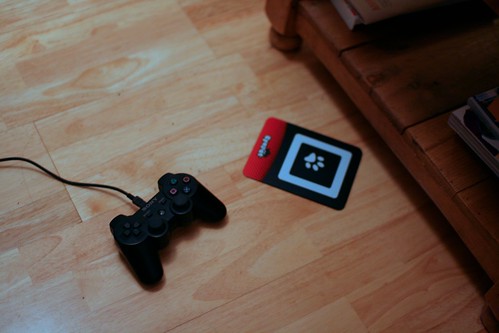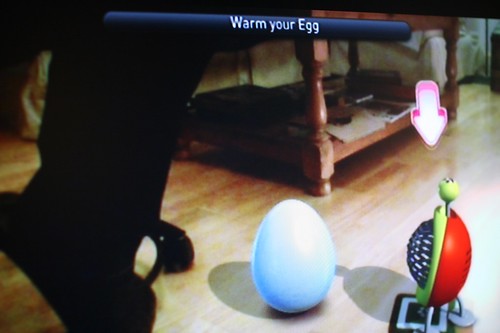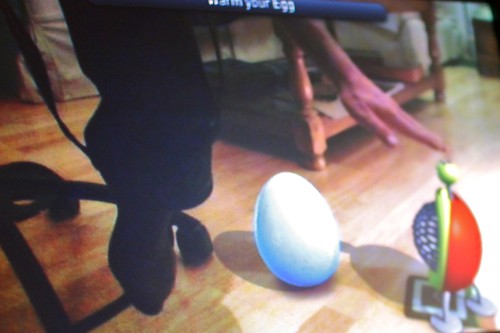 Into testing Eyepet, a game for the PlayStation 3 that is based on Augmented Reality. It basically uses the PlayStation Eye camera to allow you to interact with a virtual pet and objects in the real world. The process is very straight-forward. You have this black plastic placard shown on the picture above with a white square and a paw-print on it that you carefully place on your floor next to your TV set. The PS3 Eye recognizes it (as well as the environment): your surroundings then appear on your TV. You can start fooling around with an egg that soon becomes a gremlin-like pet. The game mechanic is progressive and based on interacting with the virtual animal either by touching (I mean, moving around in front of your TV that see on the screen what you're touching) OR by using virtual objects by holding the card (which has a symbol that is recognized by the system and make the digital item appear on the screen). See for example the following case:
Into testing Eyepet, a game for the PlayStation 3 that is based on Augmented Reality. It basically uses the PlayStation Eye camera to allow you to interact with a virtual pet and objects in the real world. The process is very straight-forward. You have this black plastic placard shown on the picture above with a white square and a paw-print on it that you carefully place on your floor next to your TV set. The PS3 Eye recognizes it (as well as the environment): your surroundings then appear on your TV. You can start fooling around with an egg that soon becomes a gremlin-like pet. The game mechanic is progressive and based on interacting with the virtual animal either by touching (I mean, moving around in front of your TV that see on the screen what you're touching) OR by using virtual objects by holding the card (which has a symbol that is recognized by the system and make the digital item appear on the screen). See for example the following case:
 Here I am, trying to activate a heater to warm-up an egg. The point is to push the lever below the pink arrow.
Here I am, trying to activate a heater to warm-up an egg. The point is to push the lever below the pink arrow.
 Pushed, now I can warm the egg.
Pushed, now I can warm the egg.
The gesture-based interaction works pretty well, especially when using virtual items. However, what is definitely tough here is that you have to act in front of your TV in a mirror-way: moving an object on the right (on the screen) requires that you move your hand on the left. This reversed-then-flipped mirror image of your room is a bit disorientating for me; i guess it may be difficult for kids as well. In the preliminary gameplays you need to make your pet jump several on a trampoline, so you really need to be accurate when you move it around so that the pet doesn't fell down on your floor. That being said, I found intriguing to have this sort of setting where you make gestures in the physical world and you access some sort of mirror-world on the TV. I do think however that game designers could play more on that trick.
There is also an impressive feature that enables you to draw things on a sketchbook... which are then translated into virtual items in the game. You draw a picture, hold it up in front of the camera and the system will try to copy it (it only works with good lighting conditions).
Why do I blog this? My interest in this sort of things is connected to by my research about interaction design and my interrogations about the role of uselessness in robots/networked objects.
Of course it's a bit frustrating (game mechanics are quite basic, loading times are long) but there are really some interesting interaction ideas in there. I am personally not sure about the virtual pet thing (why does those thing ALWAYS have to look like boring gremlins?) but this is an interesting step in the evolution of virtual/digital interlinkages.